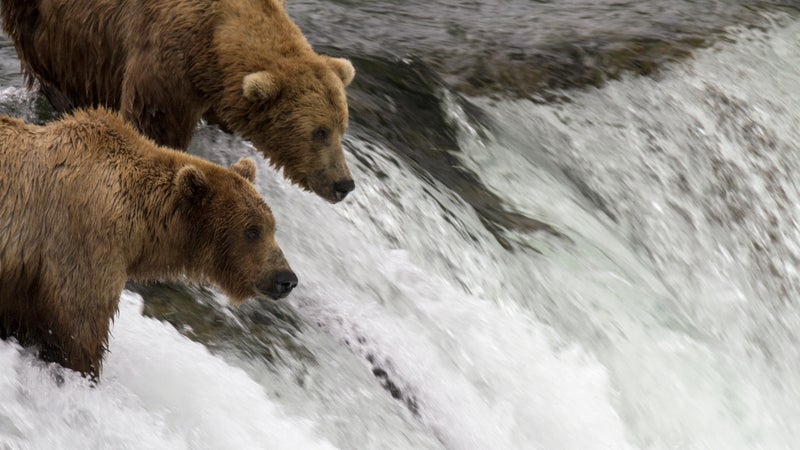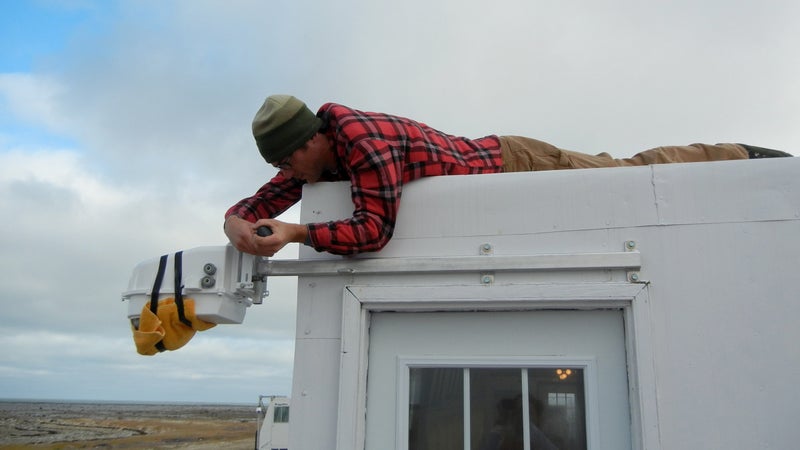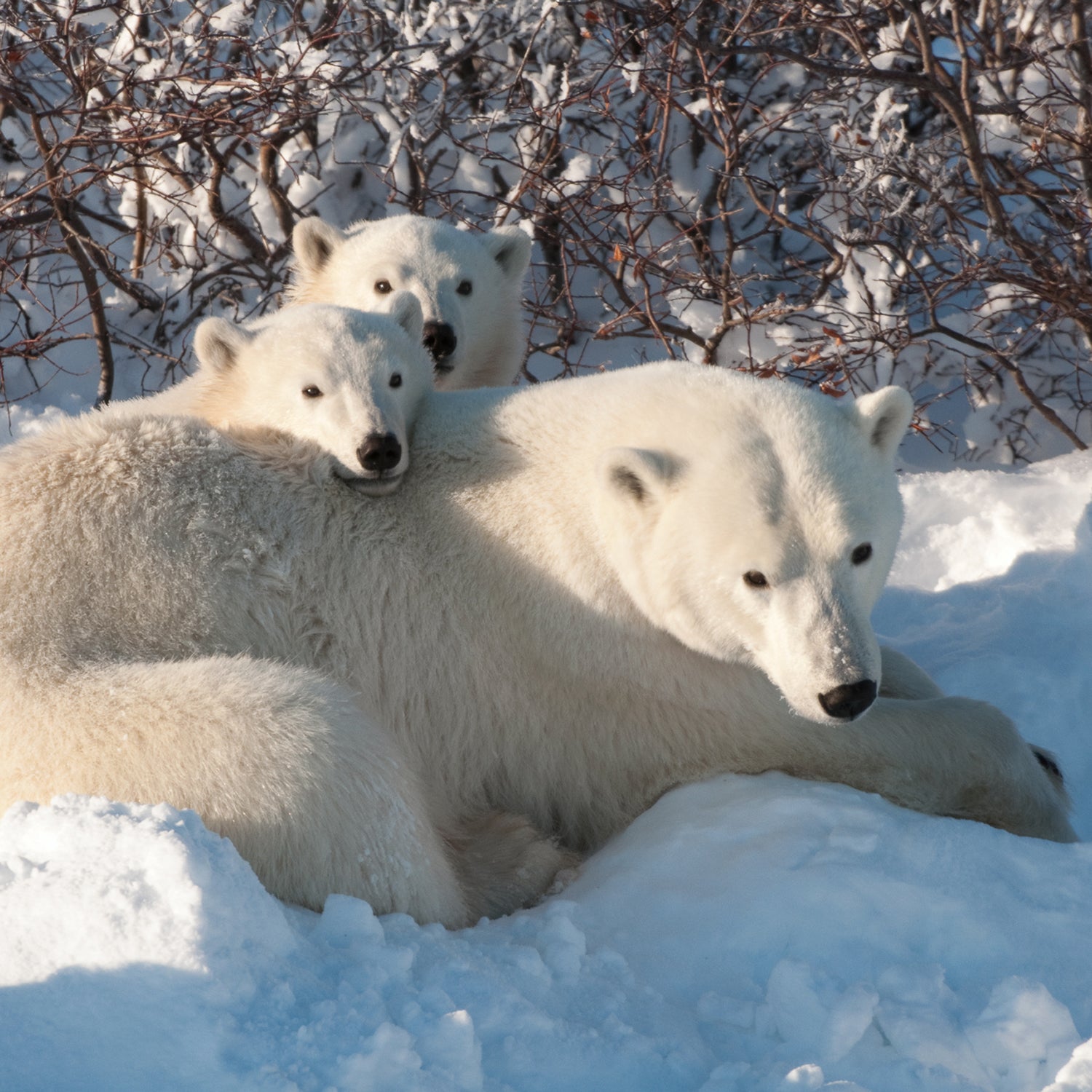Last July, a bear named Divot accidentally got her head stuck in a wolf trap just outside the boundary of Katmai National Park in Alaska. She wrenched herself free from the ground, but the snare coiled around her like a necklace, slowly decapitating her. Not long after, she wandered over to Brooks Camp, a campground and visitor’s center where summer travelers come to watch grizzlies. ��
Under normal circumstances, park rangers would have quietly launched an investigation and possibly a rescue then updated the public with a press release once everything had been tidily wrapped up. Divot, however, happened to parade right in front of a live-streaming wildlife webcam that had been set up in the park—and bear lovers from around the world flooded the with thousands of demands for immediate action.

Eight park staff members launched a rescue mission on the ground while three others searched for Divot from a plane. One ranger spotted her from a cabin that morning, ran outside in her pajamas, and followed the bear for more than a mile. In this remote wilderness, it took about two days to get tranquilizers, find a biologist licensed to administer them, mobilize the staff, track the bear, and tranquilize and treat her—a pittance for rural Alaska but an eternity by social media standards. Meanwhile, rangers ��and updated the webcam forums. The bear was saved, and viewers were satisfied—so much in fact that they sent more positive letters than the regional director had seen in his career.
Divot’s rescue was a testament to the rise in popularity of live-streaming wildlife webcams over the last five years. It’s now possible to watch the real-time, intimate details of creatures’ lives all over the planet—walruses and bears in Alaska, beluga whales in Manitoba, puffins in Maine, deer in Pennsylvania, wolves in Minnesota, and hummingbirds in Brazil. And people tune in from around the world. On a good day, the bear cams at Katmai draw 19,000 viewers from as far away as Iran and the Vatican. “I always wonder if the Pope is on there after-hours, watching the bear cams, kicking back with a glass of wine,” says Roy Wood, a ranger in Katmai National Park.��
There are few comprehensive statistics on their use, but the largest wildlife webcam provider, Explore.org, a Santa Monica philanthropic organization that showcases wildlife on live feeds, has expanded in the past four years from one animal webcam covering polar bears in Manitoba to about 100, including a watering hole in Kenya, a bee hive in Bavaria, and a reef in California. In the same period, those webcams have logged more than 500 million views.��
Environmentalists laud webcams as unprecedented tools to get more people to care about conservation, especially places few people will ever have the time, money, or vacation time to visit. “It’s opening up the planet to places people can’t see,” says David Wilkie, director of conservation support at the Wildlife Conservation Society.
��
But they could also��be distorting our perception of wilderness by��breeding unprecedented familiarity with individual animals. “There’s the worry that focusing too much on an individual animal might motivate the wrong kinds of protective actions,” says Susan Clayton, a professor of psychology and environmental studies at the College of Wooster in Ohio who has studied human connections to zoo animals.��
For example, a Michigander may become attached to saving an injured deer that appears on her computer screen, even in the face of overpopulation, a more pressing problem. We also have a tendency to relate to animals we care about as pets, making us want to insulate them from the cruel nature of the environment they live in. As we gaze deeper into the realities of nature, it’s worth considering the expanding role of webcams in conservation movements. Does it matter that viewers might get upset when an unsuspecting black-and-white colobus monkey gets eaten by a leopard on camera?
Conservation organizations have long known that the best way to get people to notice a big issue is to pull at their heartstrings with a smaller, more emotionally accessible story. In her 1971 book, In the Shadow of Man, for example, Jane Goodall divulged the social dramas of individual chimpanzees. In the past 20 years, images of stranded, emaciated polar bears have come to embody the effects of climate change. The tactic has proven effective for decades, but there has never been a technology that so effectively and inexpensively disseminates those stories.��
“It’s controversial, but more and more people are coming to the conclusion that a little bit of anthropomorphism can be a good thing because it allows you to empathize,” says Clayton. “Just knowing that a particular species is endangered, that might cause a purely intellectual concern, but we need the emotional component to start to really care.”��

The human mind is wired to understand the world through stories, and on some occasions the dramas unfolding on webcams have been able to viscerally illustrate bigger issues. Since 2012, the National Audubon Society and Explore.org have run several webcams focused on puffin nests off the coast of Maine. Not long after the webcams went live, viewers and scientists noticed that one adorable little chick, Petey, was having a hard time swallowing the saucer-like fish his parents brought him. Researchers discovered that the cold-water herring and hake puffins usually collect were in short supply, so they were bringing more abundant butterfish, which typically live in warmer waters. After weeks of unsuccessfully trying to choke down the oversize fish, Petey .��
“One of the challenges of climate change is it doesn’t happen quickly and it’s kind of a slow process and it’s back and forth, but when you see a bird that’s gagging on a warm-water fish, all of the sudden you begin to see how these changes can be life or death to individuals,” says Stephen Kress, director of the Seabird Restoration Program and vice president of bird conservation for the National Audubon Society.
Ultimately, the environmental community is overwhelmingly supportive of webcams, and all of the conservationists interviewed for this story agreed that the benefits—education, engagement, and scientific research—vastly outpace the potential drawbacks, such as the work they require of already taxed staff members and the media firestorms they can occasionally create. The key to leveraging their power is educating viewers on the nature of their wild behavior and effectively linking individual stories to the larger conservation issues.��
“It’s a bit of a dance,” says Joel Dunn, president and CEO of Chesapeake Conservancy. “Our Facebook page lights up with questions about the biology of the animals, which is a great opportunity, but it also requires a staffer or volunteer to answer those questions and they need to have some expertise. But the benefits far outweigh the costs in my opinion.” And there are some direct results: Dunn’s organization has received over a million hits on its website just this year and 100 donations as a direct result of their webcams. ��
In some cases, webcams have allowed researchers to learn more about a species’ behavior or plight, such as the case of the puffins’ change in diet, and regular viewers have made rare observations that have contributed to science. One visitor and webcam viewer in Katmai National Park documented one of the rare instances of grizzly bear cub adoption. In a few cases, viewers have also alerted authorities to illegal activity. In the same park, a person put on a wetsuit at the base of Brooks Falls and tried to snorkel with the salmon and bears—right in front of the underwater webcam. There’s also the pure entertainment value—people have watched an eagle , a bear sow give birth, and beluga whales .��
“People are making intense connections that staff in the Park Service used to think you could only get when they were actually at the park,” says Roy Wood. “In addition to the sheer numbers, the comments are really moving.” Wood has received letters from cancer patients who watch the bears during chemotherapy treatments to calm their nerves, teachers who use them to connect to students, and even an ex-gang member in Los Angeles, who was part of an anti-recidivism program and said that volunteering to remotely steer the bear webcams helped get his life on track.
Most conservationists expect webcams and streaming technology to improve and proliferate over the coming years. “We’re really just on the tip of the iceberg as to what can be done, especially from a conservation perspective,” says Tom Pollak, executive producer for Explore.org. He says that technology has advanced drastically in the last ten years, and emerging satellite products may make it more feasible to set up cameras in even more remote locations. Wilkie predicts that the next evolution in the technology will include GoPro-like body cams for wildlife.��
“It’s going to be much more what did the elephant see as it was walking through Nepal? What’s a black-and-white colobus seeing as it spends its day?” says Wilkie. “Cameras are going to get small enough and with mesh networks,” in which multiple computer users are wirelessly connected and share information, “even the forests could be connected. Rather than a gigantic transmitter, you’d have a tiny transmitter that just needs to talk to the nearest way station.”��
Like many conservationists, Wilkie believes that developing new technology like this is critical to engaging the next generation of screen-savvy digital natives, even if it means they catch glimpses of nature’s bloodier side.
“Just caring about one individual is not going to solve our ecosystem-wide problems or may be somewhat of a distraction, but I would also argue that that passion can drive an entire societal ethic,” says Joel Dunn of Chesapeake Conservancy. “And that ethic leads to people that vote for politicians that will prioritize the environment, it helps them donate to groups like ours that try to protect these places and species, and it breeds the next generation of conservation leader.”��


